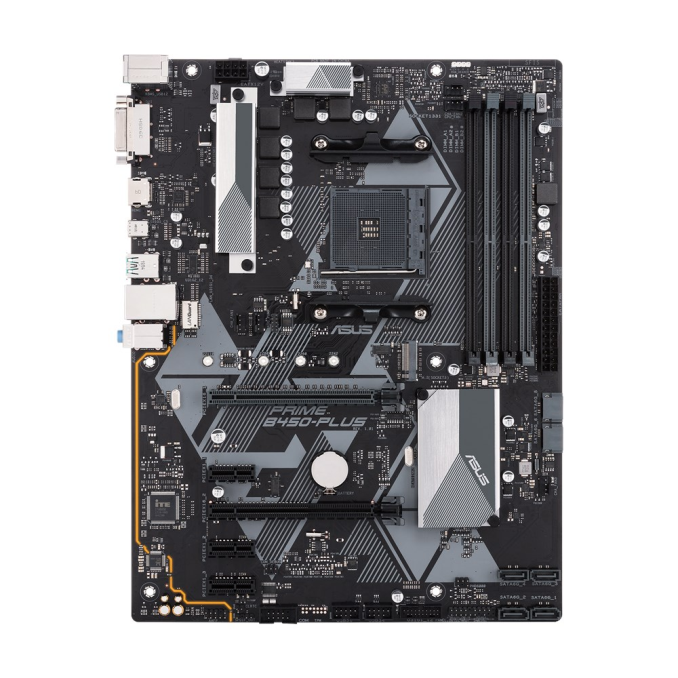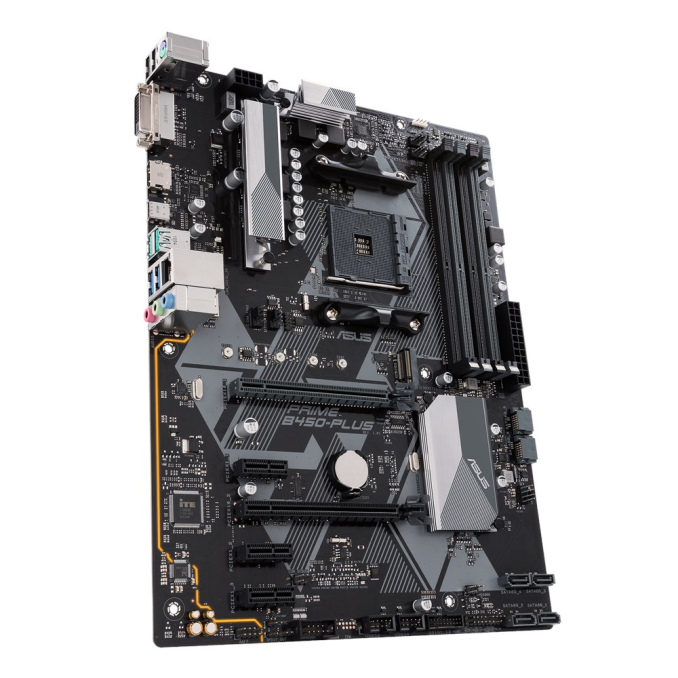Analyzing B450 for AMD Ryzen: A Quick Look at 25+ Motherboards
by Gavin Bonshor on July 31, 2018 8:00 AM ESTASUS Prime B450 Plus
Although the TUF and Prime brands from ASUS share similar pricing schemes with their low-cost entry-level options, the TUF series is aimed specifically for gamers, whereas the Prime range shifts to a more basic and subtle range of features and aesthetics. The ASUS Prime B450-Plus provides a solid infrastructure to build a solid and good value system upon. The main features of the Prime B450-Plus include a Realtek ALC887-VD2 audio codec with an entry to DDR4-3200 memory support at a low base price.
The aesthetics of the Prime B450-Plus ATX motherboard come through a subtle and clean looking black PCB with grey print which resembles a triangle pattern. The heatsinks across the board feature a classic looking light metallic finish, with a contrasting shade of darker grey to give extra definition. While there are no LEDs embedded into the PCB of the motherboard, a single Aura Sync-enabled RGB header is present to allow for users looking to add at least some element of RGB to their system.
In terms of PCIe, the board has two full-length PCIe slots with the top (grey) slot having a PCIe 3.0 x16 interface, and the second slot (black) taking its bandwidth directly from the B450 chipset, giving it an operational specification of PCIe 2.0 x4. In addition, a further three PCIe 2.0 x1 slots are there to give support for adapter cards such as sound cards and additional networking controllers etc.
The board has a total of four memory slots capable of supporting DDR4-3200, with a maximum capacity across the available slots of up to 64 GB. Both non-ECC and ECC memory are supported, with the latter entirely dependent on the used processor's capability to do so.
Providing power to the motherboard on the right-hand side of the board is a 24-pin ATX power input and between the corners of the MOSFET heatsinks is a single 8-pin ATX 12 V power input to provide power to the CPU. ASUS also advertises a 6-phase Digi+ digital power delivery on the B450-Plus Prime motherboard which is standard across their low-mid range (non-ROG branded) B450 chipset models.
Making up the storage is a total of six SATA 6 Gbps ports with four of them featuring straight angled connectors, whereas the remaining two located below the 24-pin ATX motherboard power input is right-angled. As with all of the B450 motherboards at launch, the SATA 6 Gbps ports support RAID 0, 1 and 10 arrays. A single M.2 slot is located just above the top full-length PCIe 3.0 x16 slot and has support for both SATA and PCIe 3.0 x4 M.2 22110 (22 x 110 mm) SSDs.
In relation to cooling options, the Prime B450-Plus has a total of five 4-pin headers with them being split between three different sections; three for case fans, one dedicated to the CPU fan and one for use with an AIO CPU cooling pump. A clear CMOS jumper is located towards the bottom PCIe 2.0 x1 and there’s capability to expand the featured USB connections by a further two USB 3.1 5 Gbps and four additional USB 2.0 ports thanks to internal headers.
The rear panel on the Prime B450-Plus is a variety of connections including two USB 3.1 10 Gbps Type-A ports, two USB 3.1 5 Gbps Type-A ports, two USB 2.0 ports and a single USB 3.1 5 Gbps Type-C port. Also features is three 3.5mm audio jacks with the onboard audio being powered by the Realtek ALC887-VD2 audio codec, and the single LAN port being handled by a Realtek RTL8111H Gigabit networking controller. To make use of the Ryzen 2000 series APUs is an HDMI and DVI-D output, with a single PS/2 keyboard/mouse combo port finishing off the rear I/O.
While the Prime range is a relatively basic and standard foundation to create a new system, the limitations are on the rest of the components and not the motherboard itself. The Prime B450-Plus looks good for a user not looking for anything too fancy, without paying extra for premium controllers such as the Realtek ALC1220 audio codec; the launch pricing of $109.99 signifies the intent to offer decent quality at a low entry price.





_thumb.png)
_thumb.png)
_thumb.png)
_thumb.png)
_thumb.png)
_thumb.png)








62 Comments
View All Comments
bi0logic - Tuesday, July 31, 2018 - link
It looks like the price link to the "TUF B450-Plus Gaming" is going to an amazon search for "ASRock B450M Pro4"eastcoast_pete - Tuesday, July 31, 2018 - link
Thanks Gavin, I know this is a lot of information to go through and present. I would love to see a follow-up on these questions:1. Especially for these compact boards, any problems with stock processor heat sinks blocking DIMM slots, i.e. do DIMMs with heat spreaders still fit with a Wraith or Spire cooler, respectively?
2. I have my eye on the Aorus Pro WiFi or something similar, but am wary of the placement of the WiFi antenna connectors right next to two of the USB 3 connectors. I frequently use 3-4 USB 3 devices at the same time frequently, and am wary of the USB 3 - WiFi interference with that placement. Any chance Gigabyte could state if/that they got that taken care of?
Thanks!
Also, still looking forward to your Ryzen 2200/2400 GPU overclock chapter on that duo. Any chance we'll see it soon?
sonofgodfrey - Tuesday, July 31, 2018 - link
Second to last table is labeled X470 Motherboards.PingSpike - Tuesday, July 31, 2018 - link
It looks like the ASUS ROG STRIX B450-F GAMING inherits some of the layout features of the (much more expensive) x470 Crosshair 7 in that it steals some of the CPU lanes to get a second full PCI-e 3.0 M.2 slot. Then 8x goes to PCI-e 16 1, the remaining 4x to PCI-e 16 2 and finally a chipset PCI-e 2.0On the surface, this seems like it has totally ignored the bifrucation limitations that supposedly are inherent to the B450 chipset.
In other words, I thought you couldn't get that on this chipset.
Dragonstongue - Tuesday, July 31, 2018 - link
well at least the pricing is "more inline" with the pricing they should be, newer boards, better componentes that actually save the maker a bit of coin per board made, so they keep the same "launch price" is acceptable in my books coming from gen 1 (I so hate the naming AMD used for Ryzen 1xxx and 2xxx needless confusion for nothing)x3xx to x4xx same concept, reduced price to produce so they save some money, but the vast majority of vendors used these "savings" to cram more disco light show RGB on the boards to jack the price up some instead.
seems at least with the B4xx boards the vendors took a "better" approach beyond a few more "premium" boards which rightfully have an increased price (justifiable, maybe, but I myself have zero need of RGB and would only buy a more expensive board that offered them at the increased price if they were WORTH it as far as just overall better then lower cost boards, sadly, there seems to be little difference in more "premium" beyond a butt load of extra RGB little better in VRM etc which are much more useful and required IMO)
they could almost have a market for the premium boards RGB free, so pay a bit less for people like me who do not want all the RGB crud but still get the increased premium sound/VRM/BIOS etc ^.^
WasHopingForAnHonestReview - Wednesday, August 1, 2018 - link
Nice review. Good work.Im amazed that almost every comment is a nitpick. Rough life, Ian.
Flappergast - Wednesday, August 1, 2018 - link
Nice overview on the last page. I’m looking for mITX WiFi - nice to see some good boardsSakkura - Wednesday, August 1, 2018 - link
As documented by Buildzoid, the Asrock B450 Pro4 does not have the claimed 6+3-phase VRM. It is a pure 3+3-phase. Same probably applies for the B450M Pro4.https://youtu.be/yWAwOH-egFs?t=2104
JohanPirlouit - Wednesday, August 1, 2018 - link
Hi everyone,Am I the only one to see that on the AMD picture:
- CPU: 2x SATA 3Gbps
- Chipset: 6x SATA 3Gbps
What do AMD talks about: SATA "3" (known as "6Gbps") or SATA 3Gbps (aka SATA II)?
Sakkura - Wednesday, August 1, 2018 - link
They mean SATA3 = SATA 6Gbps. Annoying that we keep running into these easily confused naming schemes (see also: USB 3.1 Gen1 and Gen2). At least SATA is getting old enough that we should soon be able to just drop the version number (unlike USB 2.0 there's really no reason to make modern hardware with SATA2).